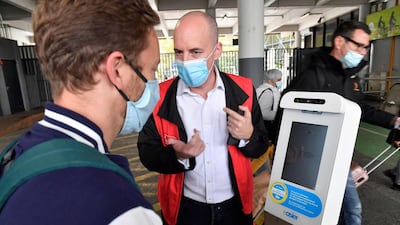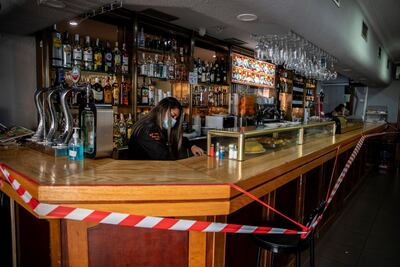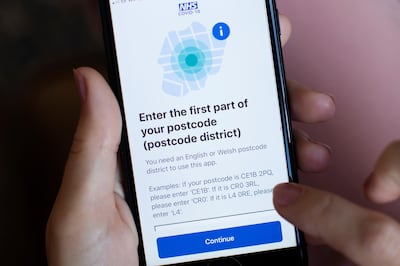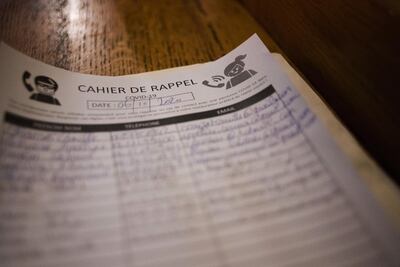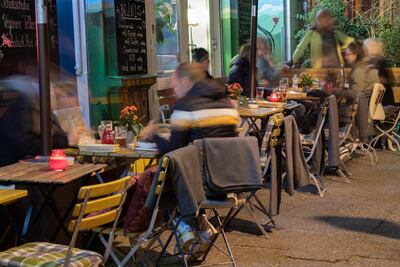Failings in contact tracing have been linked to the rapid spread of coronavirus around several major European countries.
Research by The National, backed by experts, reveals that widespread Covid-19 testing is ineffective without thorough contact tracing.
Britain has conducted 25 million tests, the most in Europe, and on Thursday recorded its highest daily infection rate at 17,500. By comparison, Germany has conducted 16 million tests yet, its highest recent infection day was 4,400.
Countries with good contact tracing, such as Germany and Italy, appear to be suffering only a minor second wave.
For every person who tests positive in Taiwan, 17 people are called as part of contact tracing. Canada, China, Germany, Italy, Japan and Singapore have been praised for having similarly big test and trace programmes with subsequent low infection rates. In Britain the figure is four people contacted per positive test, and in France and Spain the trace number is just three.
German Chancellor Angela Merkel said Friday that the country was adopting emergency restrictions, with the ultimate goal of keeping the number of infections in a range in which the chains of infection can be traced.
In England, an independent group of scientists warned that it was too late to rely on contact tracing to contain the pandemic. Professor Karl Friston of University College London warned: "The window of opportunity for enhanced contact tracing has passed.
"No amount of contact tracing will work at the moment. It's gone too far."
The country’s National Health Service contact app has been beset by technical issues, leading to its rollout four months late.
A report claimed that the app system had sent just one alert from a venue since its launch two weeks ago despite being used millions of times by customers ‘checking in.’
Despite its wealth and resources, the US has the worst contact tracing among the countries examined, with the state of Maryland performing best with only 1.6 people traced after a positive test.
The US has the world's highest number of deaths (213,000) and infection (7.64 million).
"Britain is currently doing the most tests in Europe but [among] the worst tracing,” said Prof Julian Peto, a statistician and epidemiologist at the London School of Hygiene and Tropical Medicine.
“Germany is doing well with test and trace whereas the UK, despite the high number of tests, has been much less effective in tracing,” said Dr Ilan Kelman, Professor of Disasters and Health at University College London. “Germany is implementing much more appropriate measures than Britain and France and Spain, but individuals also have a role to play.”
The daily death rate in France, Britain and particularly Spain is rising at worrying rates, although the rates are currently not as high as during the first wave. The average daily deaths experienced by Spain (102) France (71) and Britain (56) are significantly higher than in Italy (23), Germany (12) and Belgium (13).
Currently, the high infection rates are not overwhelming hospitals, but fears remain that if the virus is not brought under control there will be a catastrophic winter ahead.
The coronavirus has not yet experienced a full European winter where, with global warming, average temperatures are around 7ºC. This is the same temperature as at meat packing factories which are known as places where the virus has thrived, with several infection hotspots traced to them.
Scientists believe that much will depend on individual behaviour on abiding by rules. In Britain, one survey found that only 20 per cent of those with Covid-19 symptoms self-isolated as required. Earlier this month, a Member of Parliament was urged to resign for travelling down from Scotland to London by train, having tested for Covid-19, and then returning by train when told the result was positive.
“Our behaviour is a key factor,” said Dr Kelman. “We know people are exhausted and frustrated and that is why there are objections to severe measures but if there is no social distancing then there will be no end to this.”
The UK government is expected to sign off on a three-tier system of lockdown restrictions next week to try to bring down the spiralling cases amid concerns its tracing system will not be enough.
Under the new system, pubs and restaurants could be closed in the worst-hit areas, while a ban on overnight stays is also being considered.
Countries that have introduced alert systems early on during the pandemic have found that it is a policy that helps reduce infections.
New Zealand, Germany and Australia all brought in a ‘traffic light’ system, either at the start or a few weeks into the pandemic, and have all been able, so far, to contain a second wave of infection.
Now Britain is belatedly considering the system as it faces a record number of cases, with 17,500 on Thursday, using a traffic light system of local restrictions to prevent a nationwide spread.
While contact tracing and testing are vital to containing the disease, it now appears the government’s greater worry is preventing a widespread outbreak that would cripple Britain’s economy and overwhelm its health system.
However, Westminster is far behind other countries in bringing in a warning system. New Zealand introduced a four-level alert system in March, almost as soon as the pandemic was declared. Similarly, parts of Germany did the same in May. Both countries now have significantly lower infection rates.
How traffic light systems have been adopted
Britain
The government has brought in local lockdown measures in addition to the nationwide restrictions already in place. It is expected to introduce the traffic light system in the coming days in England. Alert Level 1 reflects the current situation with a “rule of six” for gatherings, wearing face-masks, a 10pm bar and restaurant curfew, and only 15 people allowed at a wedding and 30 at a funeral.
At Level 2 people must not meet anyone outside their household bubble. It will be introduced with a rise in transmission, “which cannot be contained through local response”.
Alert level 3, or Red, Alert, will have the toughest local restrictions to date. No social contact allowed outside of the household, closure of pubs, restaurant and leisure outlets, no sports. Places of worship would remain open.
France
Like Britain, France has opted for localised restrictions. The Health Ministry uses a four-stage alert of pink, red, dark red and grey, which stand for alert, heightened alert, maximum alert and state of emergency. ‘Alert’ is an infection rate of 50 cases per 100,000 people. Local authorities are encouraged but not forced to put in restrictions. ‘Heightened alert’ is an infection rate above 150 cases per 100,000, in which the authorities must enforce measures such as 10pm bar closures. ‘Maximum alert’ is 250 cases per 100,000, or when 30 per cent of intensive care beds are Covid-19 patients. All bars must close for at least two weeks. Cinemas, museums and theatres will be exempt with sufficient hygiene protection. State of emergency is full lockdown.
Germany
Germany brought in its traffic light system to Berlin in May. If there are below 20 infections per 100,000 inhabitants within seven days it stays at green, if it goes over 20 then it turns yellow. If there are 30 new infections per 100,000 it goes red. If the reproduction rate is 1.1 on at least three consecutive days, the traffic light turns yellow and at a rate of 1.3, it turns red. If 15 per cent of intensive care beds are Covid-19 patients, it’s yellow and at 25 per cent it turns red. If two of the three above indicators turn red, reinstatement of lockdown measures is likely.
Spain

The Health Ministry introduced a traffic light alert system in July but it does not come with measures to be taken as infection spreads. Instead, the system gives the government an overall picture of the national situation. The level stayed at green if the seven-day incidence rate was under 10 cases per 100,000 people. Between 10 and 20 it was yellow and over 30 it went red.
